Vietnamese cuisine is one of the most beloved in the world with its rich aromas, fresh ingredients, and balanced flavors. The country’s geographical structure and historical background have left deep traces on its food culture. While light and simple flavors stand out in the north, spicier and sweeter tastes are prominent in the south. Rice, noodles, fresh herbs, fish sauce, and spices form the cornerstones of Vietnamese cuisine. Thanks to this diversity, each region has its own unique dishes and recipes.
Vietnamese dishes open the door not only to taste but also to a cultural journey. These flavors, which you can find everywhere from street stalls to luxury restaurants, are also an inseparable part of the country’s social life. The skillful combination of fresh vegetables, seafood, meat, and aromatic spices makes Vietnamese cuisine both healthy and light. From Phở to Bánh Mì, from Gỏi Cuốn to Bún Chả, each dish stands out as a special taste reflecting the country’s culture and history.
1. Phở – The famous noodle soup served in beef or chicken broth.
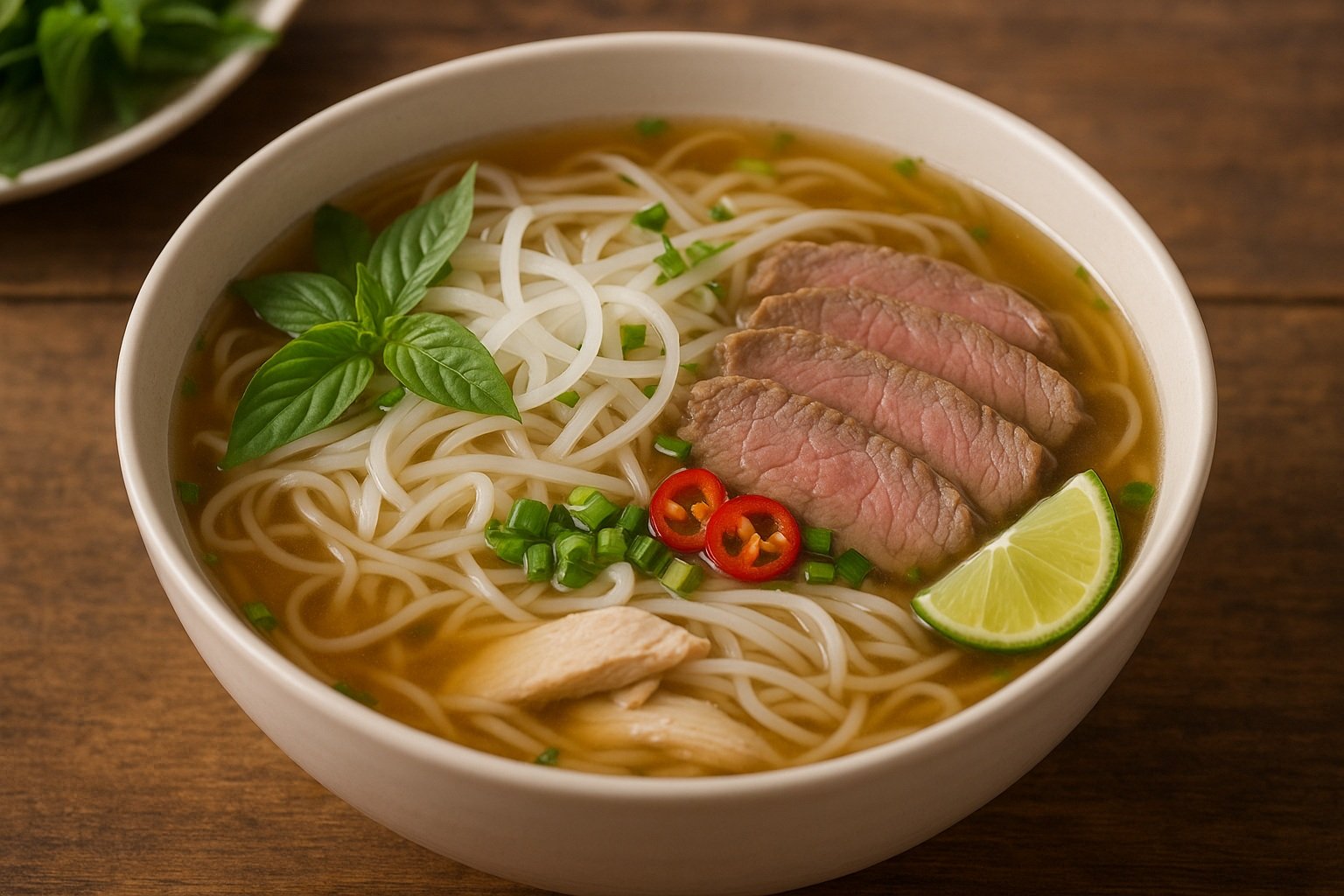
Phở is one of the most well-known and most beloved dishes of Vietnamese cuisine. This noodle soup, prepared with beef or chicken broth, can be consumed at any time of the day, from breakfast to dinner. It is usually made with beef (phở bò) or chicken (phở gà) and has an aromatic broth made by simmering bones for a long time. It is served enriched with rice noodles, slices of meat, fresh herbs, onion, lime, and chili. Thanks to its light yet filling structure, it is both nutritious and delicious.
Phở is not only a dish but also an important symbol of Vietnamese culture. Especially in big cities such as Hanoi and Ho Chi Minh City, it can be found everywhere from street vendors to restaurants. Each region has its own cooking style; in the north, it is prepared in a simpler and more aromatic way, while in the south it is made sweeter and with more ingredients. This soup, indispensable for both locals and tourists, is the most famous gateway of Vietnamese cuisine to the world.
2. Bánh Mì – Traditional sandwich prepared with French-influenced baguette bread.

Bánh Mì is a traditional sandwich inherited from Vietnam’s French colonial period and blended with local flavors, becoming one of the country’s symbolic dishes. Made with French baguette bread, this delicacy stands out with its crispy exterior and soft interior. It usually contains marinated meats, ham, pâté, pickled vegetables, fresh coriander, cucumber slices, and chili peppers. Thanks to the harmony of ingredients, it offers a taste that is both light and filling.
Bánh Mì is one of the most popular street foods and can easily be found at any time of the day. With its affordability, practicality, and variety, it has become a favorite of both locals and tourists. From Hanoi to Ho Chi Minh City, different versions are made in different cities; in some regions, varieties enriched with egg, seafood, or chicken can be found. Completed with fresh herbs and special sauces, Bánh Mì represents a unique fusion of both Western and Eastern cultures in Vietnamese cuisine.
3. Gỏi Cuốn (Spring Rolls) – Fresh rolls of vegetables, shrimp, or meat wrapped in rice paper.
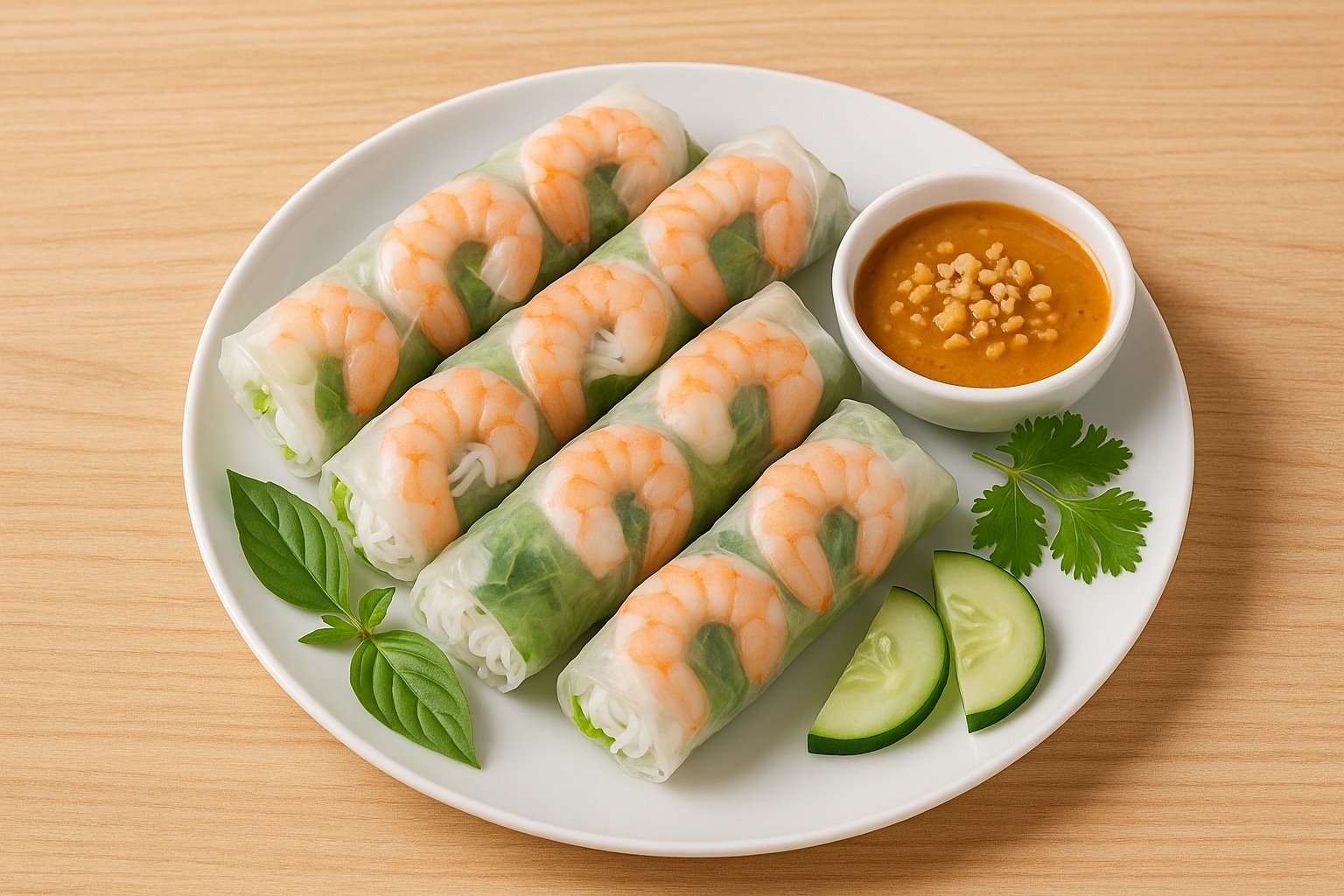
Gỏi Cuốn (Spring Rolls) is one of the lightest and healthiest flavors of Vietnamese cuisine. These rolls, prepared with fresh vegetables, herbs, rice noodles, shrimp, or thinly sliced meat wrapped in delicate rice paper, are usually served with peanut sauce or hoisin sauce. Since they are consumed fresh without frying, they are both low in calories and nutritious. Aromatic herbs such as coriander, mint, and basil used inside add a refreshing taste to the rolls.
Gỏi Cuốn is especially preferred in Vietnam during the summer months as a refreshing and light meal. These rolls, which can be found everywhere from street vendors to restaurants, also stand out with their practical preparation. Although often served as an appetizer or snack, thanks to their filling ingredients they can also be consumed as a standalone meal. With its emphasis on freshness, Gỏi Cuốn is one of the finest examples reflecting the healthy lifestyle philosophy of Vietnamese cuisine.
4. Nem Rán / Chả Giò (Fried Spring Rolls) – Crispy fried rice paper rolls.
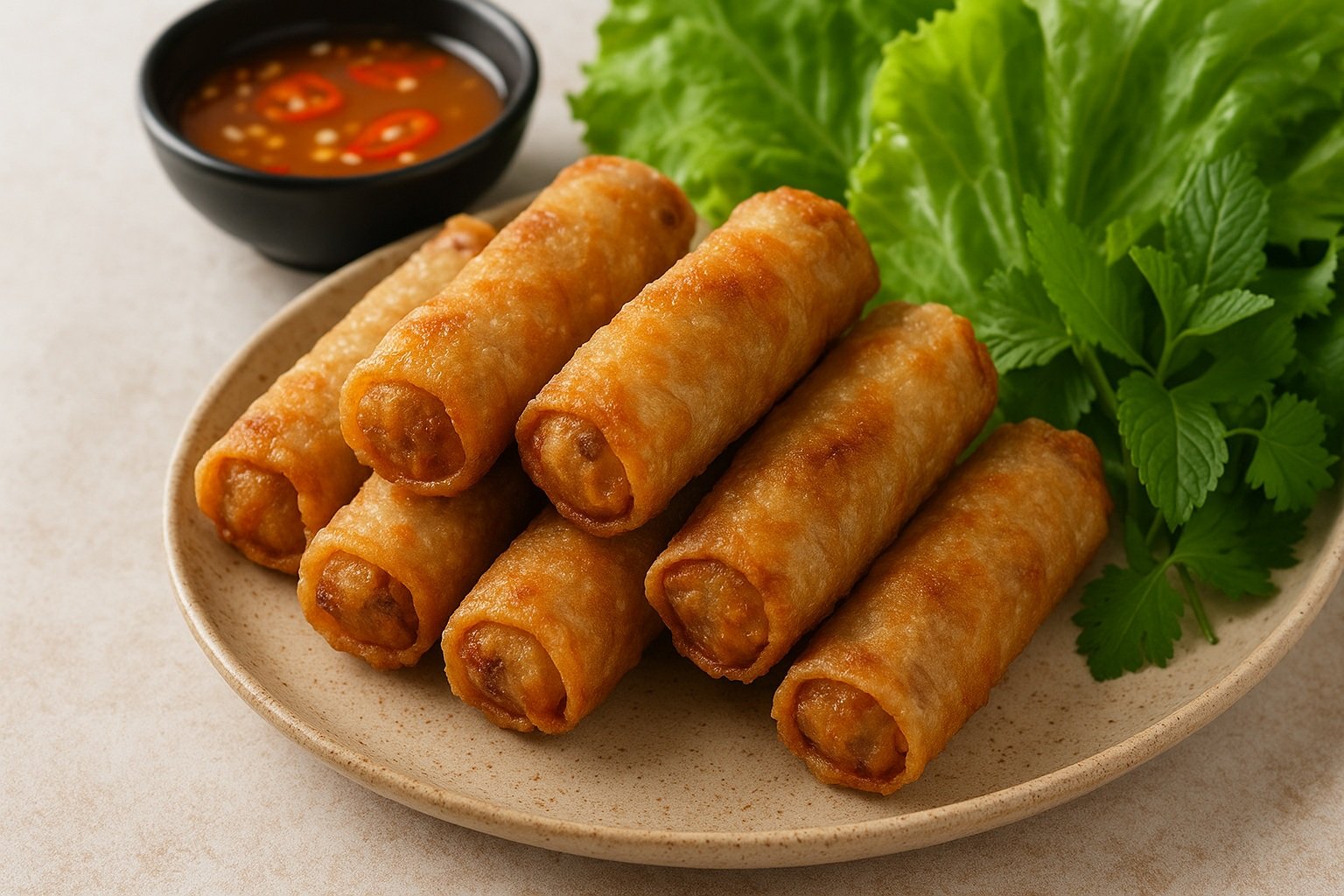
Nem Rán / Chả Giò (Fried Spring Rolls) is one of the most beloved snacks in Vietnamese cuisine. They are prepared by filling rice paper with ingredients such as minced meat, vegetables, mushrooms, glass noodles, and sometimes shrimp. These rolls are then fried until golden brown, gaining a crispy exterior and a soft, flavorful interior. They are usually served with sweet and sour sauces, fish sauce, or chili sauce. Being both filling and appetizing, they are often preferred in daily meals as well as at special gatherings.
This delicacy is known by different names in different regions of Vietnam, especially called “Nem Rán” in the north and “Chả Giò” in the south. Found everywhere from street vendors to restaurants, these fried rolls stand out with both their practicality and intense aroma. When their crispy texture combines with fresh herbs and sauces, the resulting contrasting flavors make Nem Rán not only a dish but also a special taste reflecting the cultural diversity of Vietnamese cuisine.
5. Bún Chả – Hanoi dish with grilled pork and noodles.
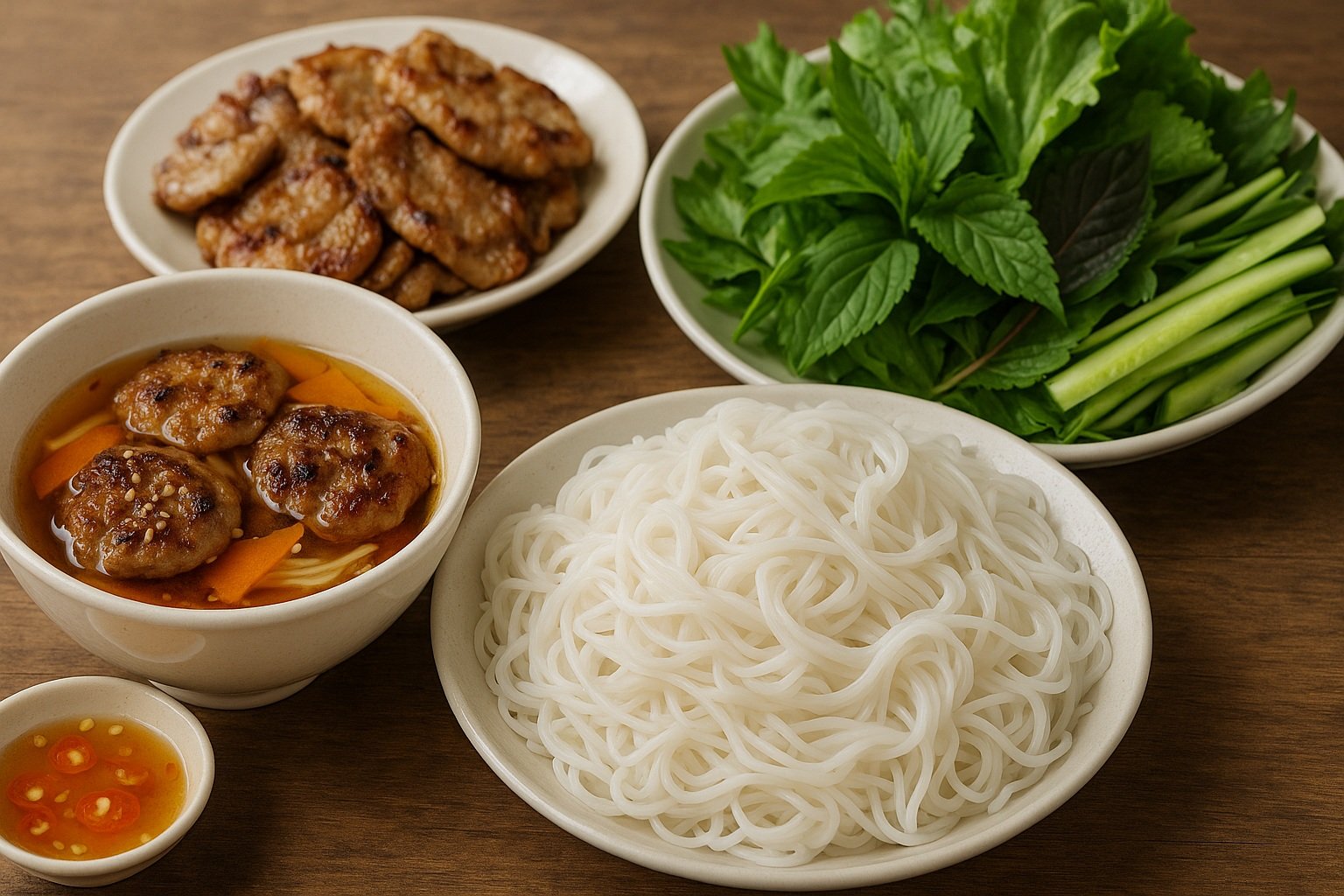
Bún Chả is one of the most famous dishes of Hanoi cuisine and is usually preferred for lunch. Thinly sliced or meatball-shaped pork is carefully grilled over charcoal. These meats are served together with rice noodles (bún), fresh herbs, greens, and a sweet and sour fish sauce with garlic. The light smoky aroma from the grill combined with aromatic herbs gives the dish a unique flavor. With its structure that is both filling and light, Bún Chả is one of the best reflections of Vietnam’s balanced culinary approach.
Bún Chả, an indispensable part of Hanoi’s streets, is traditionally served with small bowls of sauce alongside the dish. The noodles and herbs are mixed with the delicious juice of the grilled meat when eaten. Especially on hot summer days, this dish offers a refreshing experience with its cooling herbs and light sauces, making it an unforgettable flavor for both locals and tourists. As one of the most iconic tastes introducing Vietnamese cuisine to the world, Bún Chả has also become a symbol of Hanoi culture.
6. Cao Lầu – Noodle dish from Hoi An made with special rice noodles and pork.
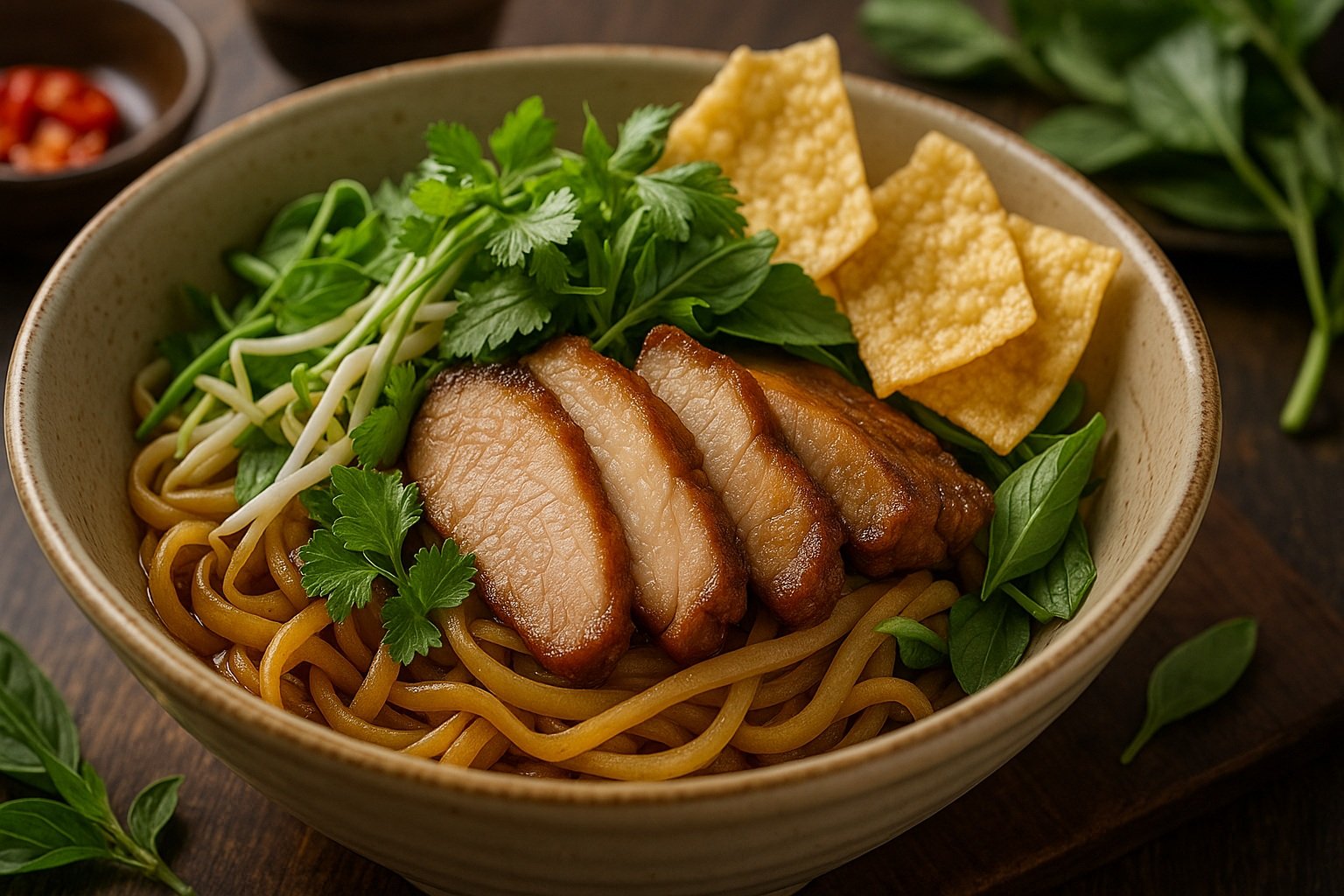
Cao Lầu is one of the most characteristic dishes of Vietnamese cuisine, unique to the city of Hoi An. This special dish is made with rice noodles prepared using water from local wells, giving them a distinctive texture. These thick and slightly firm noodles are topped with slices of marinated pork, fresh herbs, bean sprouts, and crispy rice crackers. Usually served with a small amount of aromatic sauce, Cao Lầu differs from other noodle dishes by having a drier and more intense texture rather than being in soup form.
This dish, which has become a cultural symbol of Hoi An, also reflects the city’s historical atmosphere. Being prepared exclusively here for centuries makes Cao Lầu gastronomically unique. A favorite of both locals and tourists, it is a must-try experience for anyone visiting Hoi An. With its traditional character, Cao Lầu stands out as one of the best dishes representing the regional diversity of Vietnamese cuisine.
7. Mì Quảng – A dish from the Quang region made with turmeric-flavored noodles and various meats.

Mì Quảng is a special noodle dish from Vietnam’s Quang region, with its color and aroma derived from turmeric. Prepared with wide and flat rice noodles, this dish is enriched with different proteins such as chicken, pork, shrimp, or fish. Since it is usually served with only a small amount of broth, it is denser than classic noodle soups. It is completed with bean sprouts, fresh herbs, sesame rice crackers, and crushed peanuts, creating a dish rich in both flavor and visual appeal.
Mì Quảng is one of the most important dishes reflecting the cultural identity of the Quang Nam region. Its mildly spiced and aromatic taste is a sign of the balance and diversity in the local cuisine. Found everywhere from street vendors to luxury restaurants, this dish has also become popular in different regions of Vietnam. Especially preferred during special occasions and family meals, Mì Quảng stands out as one of the unique flavors of Vietnamese cuisine with its filling yet healthy nature.
8. Bánh Xèo – Vietnamese crepe made with rice flour and turmeric, filled with vegetables and meat.
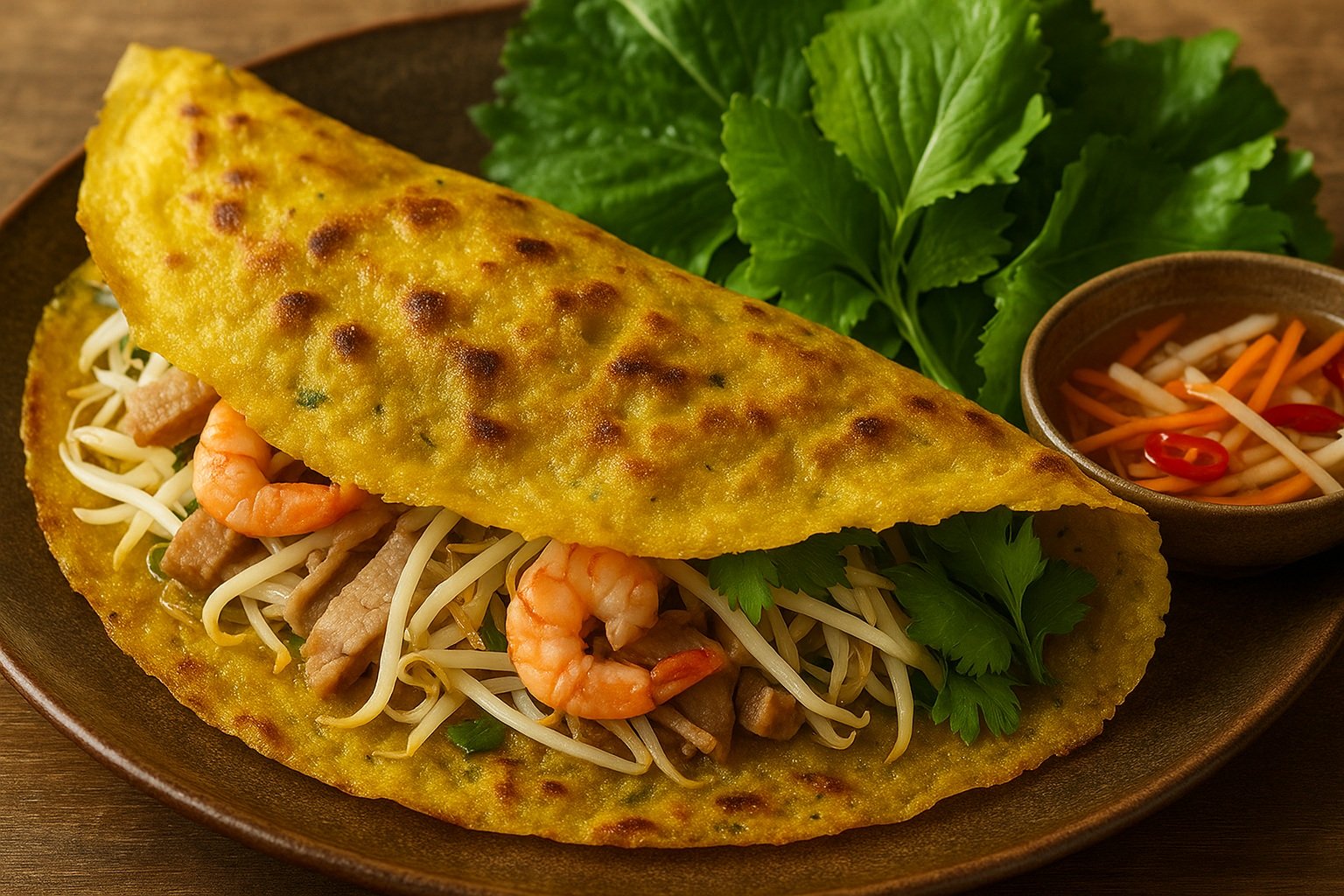
Bánh Xèo is one of the most colorful and most beloved dishes of Vietnamese cuisine. It is made by thinly cooking a batter prepared with rice flour, turmeric, and coconut milk in a pan. This batter stands out with its golden yellow color and is usually filled with shrimp, pork, bean sprouts, and vegetables. With its crispy outer surface, this crepe is eaten either wrapped in rice paper with fresh herbs or dipped directly into various sauces.
Bánh Xèo takes its name from the “sizzling” sound it makes while cooking, making the preparation process part of its identity. The filling varies across different regions of Vietnam; in the south, it is made larger and with more ingredients, while in the north, smaller and simpler versions are preferred. As one of the indispensable street foods, Bánh Xèo is both filling and suitable for sharing, making it a favorite for those who want to explore the unique flavors of Vietnamese cuisine.
9. Hủ Tiếu – Rice noodle soup with seafood or meat.
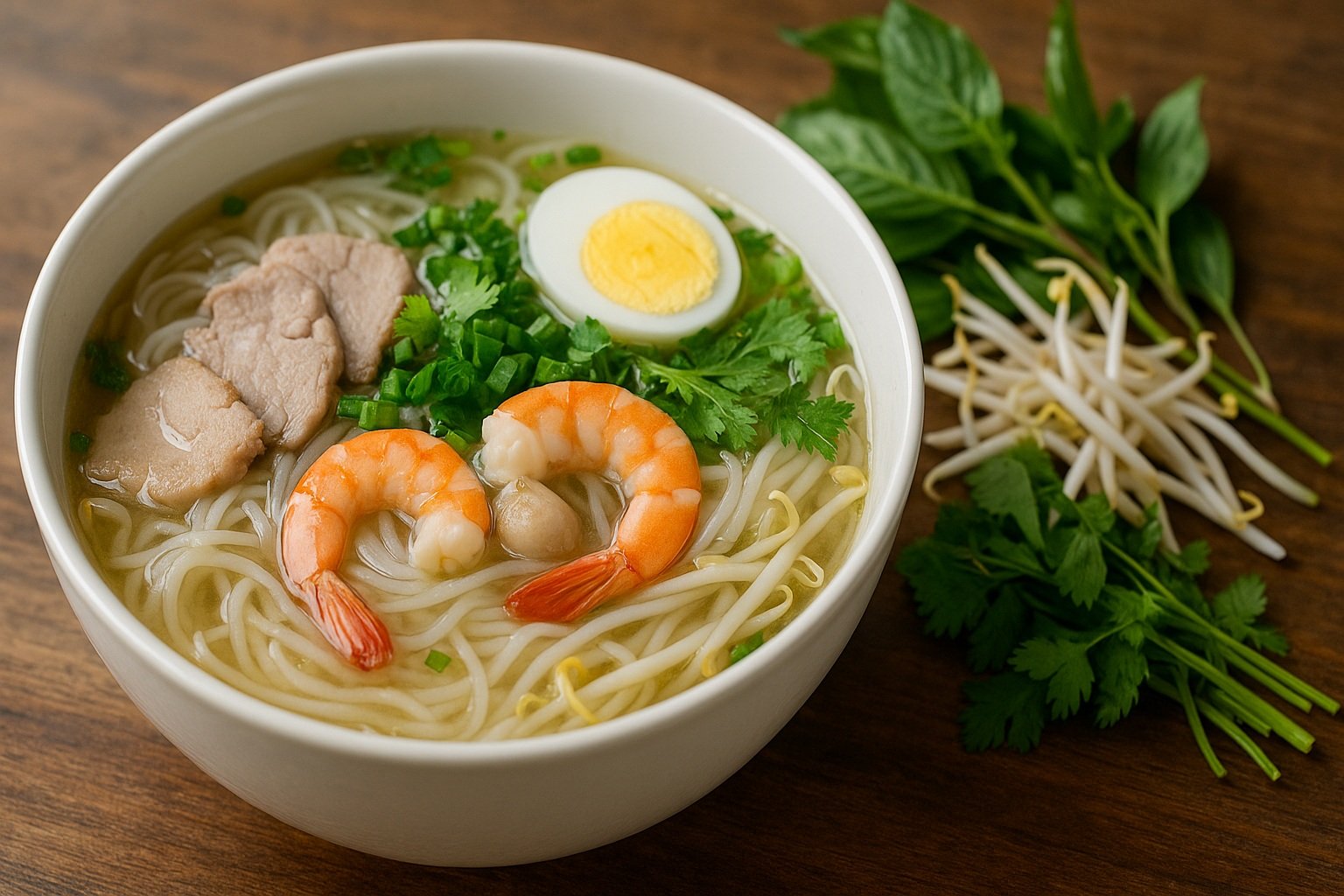
Hủ Tiếu is a light and flavorful soup made with rice noodles, very popular in the southern regions of Vietnam. It is usually prepared with seafood, pork, or chicken and served in a clear, aromatic broth. Thin rice noodles are complemented with fresh herbs, bean sprouts, and sometimes boiled egg. Enriched with various sauces, this dish can take on spicy, sour, or sweet touches depending on personal preference.
As one of the staples of street food, Hủ Tiếu can be enjoyed both at breakfast and dinner. Thanks to its variety, it has different interpretations in each region; for example, in some places it is served as a soup, while in others it appears as dry noodles. With its balanced flavor, filling structure, and fresh ingredients, Hủ Tiếu is one of the traditional dishes reflecting the richness of Vietnamese cuisine.
10. Bún Bò Huế – Spicy and aromatic beef noodle soup from the city of Hue.

Bún Bò Huế is a spicy and aromatic noodle soup unique to the historic city of Hue, located in central Vietnam. This dish features a richly flavored broth prepared by simmering beef bones and spices for a long time. It usually includes slices of beef, beef shank, pork shank, or beef meatballs. Served with round and thick rice noodles, this soup stands out with the rich flavors added by lemongrass, shrimp paste, chili, and fish sauce.
Bún Bò Huế is not only a filling dish but also a cultural symbol reflecting the character of Hue cuisine. With its spicy and strong aroma, it differs from other Vietnamese noodle soups. It is usually served with fresh bean sprouts, mint, basil, lime, and chili on the side, allowing everyone to adjust the flavor to their own taste. Loved by both locals and tourists, this dish is considered one of the most special and authentic flavors of Vietnam.
11. Cơm Tấm (Broken Rice) – Dish made with broken rice, usually served with grilled meats.

Cơm Tấm (Broken Rice) is one of the most consumed dishes in Vietnam, especially in the south, in Ho Chi Minh City. Prepared with broken rice grains, this dish is usually served with grilled pork chops, eggs, minced meat patties, or chicken. It is accompanied by pickled vegetables, fresh herbs, and fish sauce. Since broken rice has smaller grains compared to regular rice, it offers a different texture and flavor, which distinguishes Cơm Tấm from other rice dishes.
Traditionally a meal of the working class, Cơm Tấm has over time become popular both in street food and restaurant menus. Thanks to its being both filling and affordable, it can be enjoyed at any meal of the day. With its variety, it appeals to different tastes and reflects both the simplicity and richness of Vietnamese cuisine. Today, Cơm Tấm is not only for locals but also among the must-try flavors for tourists visiting Vietnam.
12. Xôi (Sticky Rice) – Glutinous rice with sweet or savory varieties.

Xôi (Sticky Rice) is a traditional dish that holds an important place in Vietnamese cuisine with both sweet and savory varieties. Made from glutinous rice, this dish is usually consumed at breakfast or as a snack. In savory versions, chicken, pork, sausage, or fried shallots are used, while sweet varieties feature ingredients such as grated coconut, beans, sesame, corn, or fruit. With its nutritious and filling structure, it can be easily eaten at any time of the day.
Xôi is often found at street vendors’ stalls and reflects a rich cultural heritage with its varieties that differ from region to region. Especially in big cities, it is very popular as a practical and affordable meal option. Decorated with colorful and diverse ingredients, Xôi appeals to both the eye and the palate, making it one of the best examples of the diversity of Vietnamese cuisine.
13. Bánh Cuốn – Thin rice batter rolls filled with minced meat.
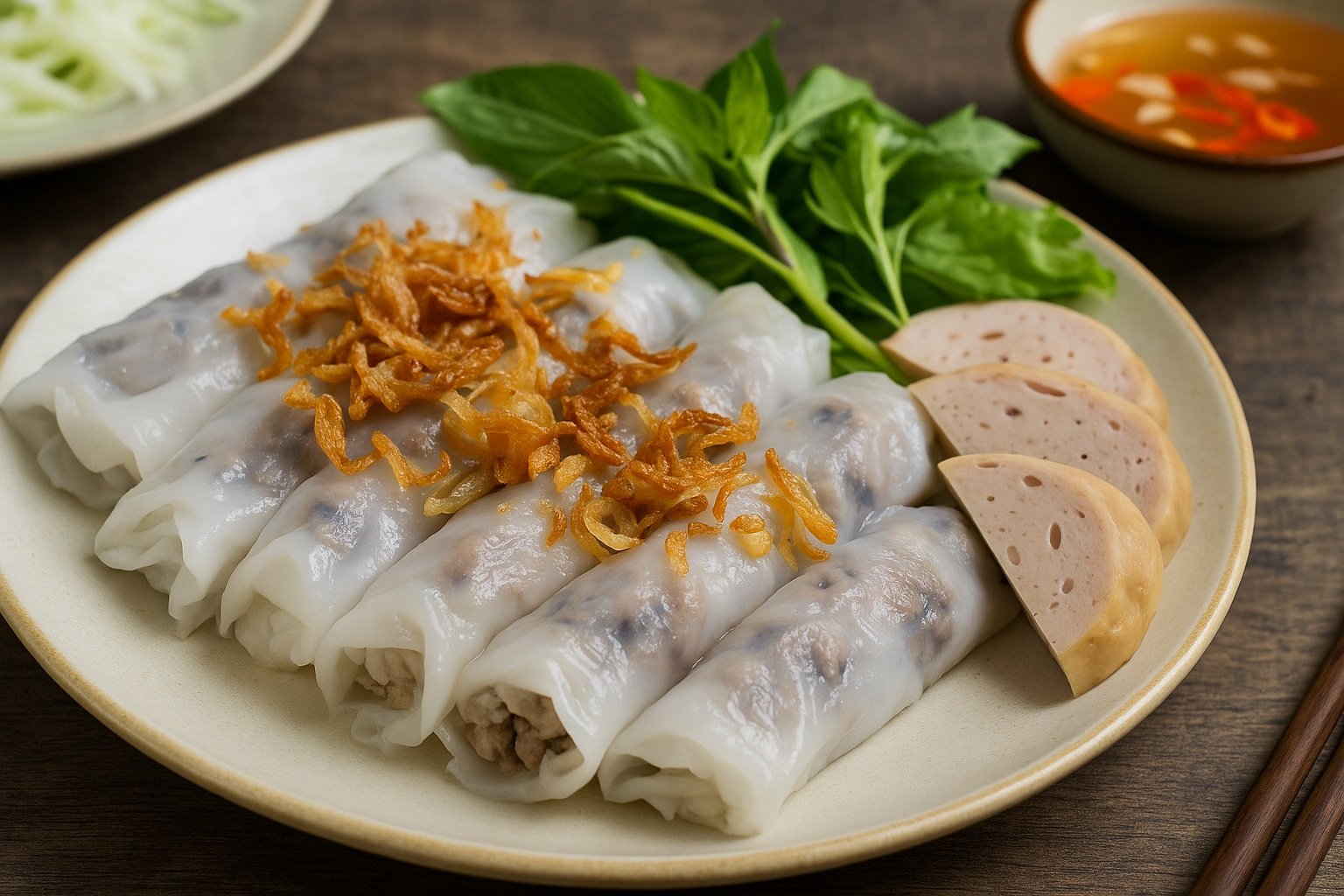
Bánh Cuốn is one of the most delicate and light flavors of Vietnamese cuisine. Thin rice batter is steamed to prepare the base, then filled with ingredients such as minced meat, mushrooms, and onions, and rolled up. It is usually served with fried shallots, fresh herbs, and boiled pork sausage or meatballs. With its light structure and silky texture, Bánh Cuốn is a traditional dish especially preferred for breakfast or light meals.
This special dish is complemented by a fish sauce–based dipping sauce with garlic and a mildly sweet and sour flavor. Often seen at street stalls in the morning, Bánh Cuốn stands out for being both practical and filling. In every bite, the thinness of the rice batter blends with the aroma of the filling, creating a unique experience that reflects the balanced flavor approach of Vietnamese cuisine.
14. Chè – Dessert made with various fruits, beans, jelly, and coconut milk.
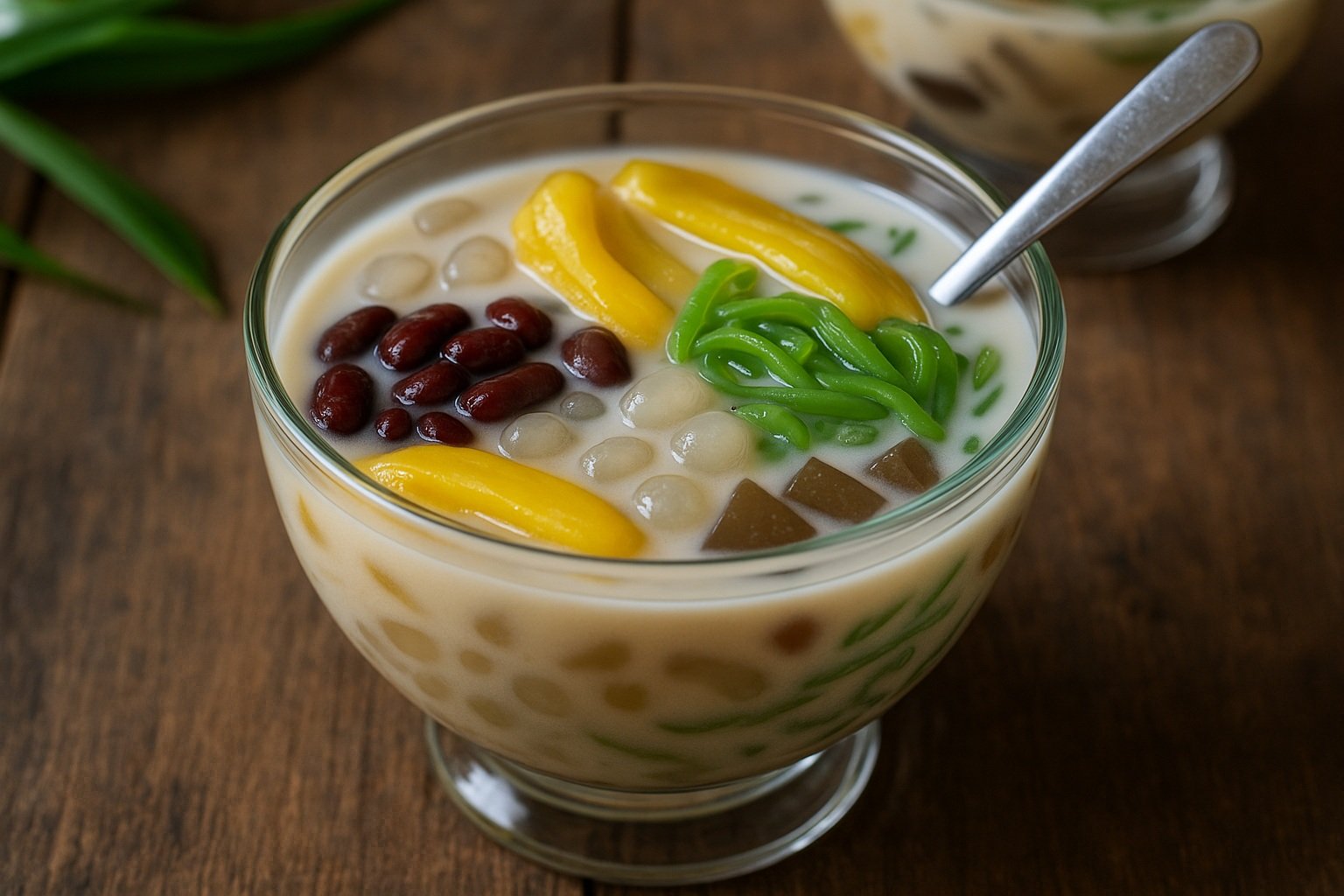
Chè is one of the most beloved desserts of Vietnamese cuisine and stands out with its wide variety. This dessert is usually prepared with ingredients such as fruit pieces, beans, corn, jelly, tapioca pearls, and coconut milk. Consumed either hot or cold, Chè offers a refreshing option especially in its iced version during the summer months. With its sweet, light, and layered structure, it appeals to both the eye and the palate.
Made with different recipes in various regions of Vietnam, Chè can be found across a wide range from street vendors to restaurants. Some varieties are creamy and rich in flavor, while others offer lighter and fruitier tastes. Both a daily snack and an indispensable dessert for special occasions, Chè is one of the flavors representing the colorful and creative side of Vietnamese cuisine.
15. Gà Nướng (Grilled Chicken) – Spiced grilled chicken.
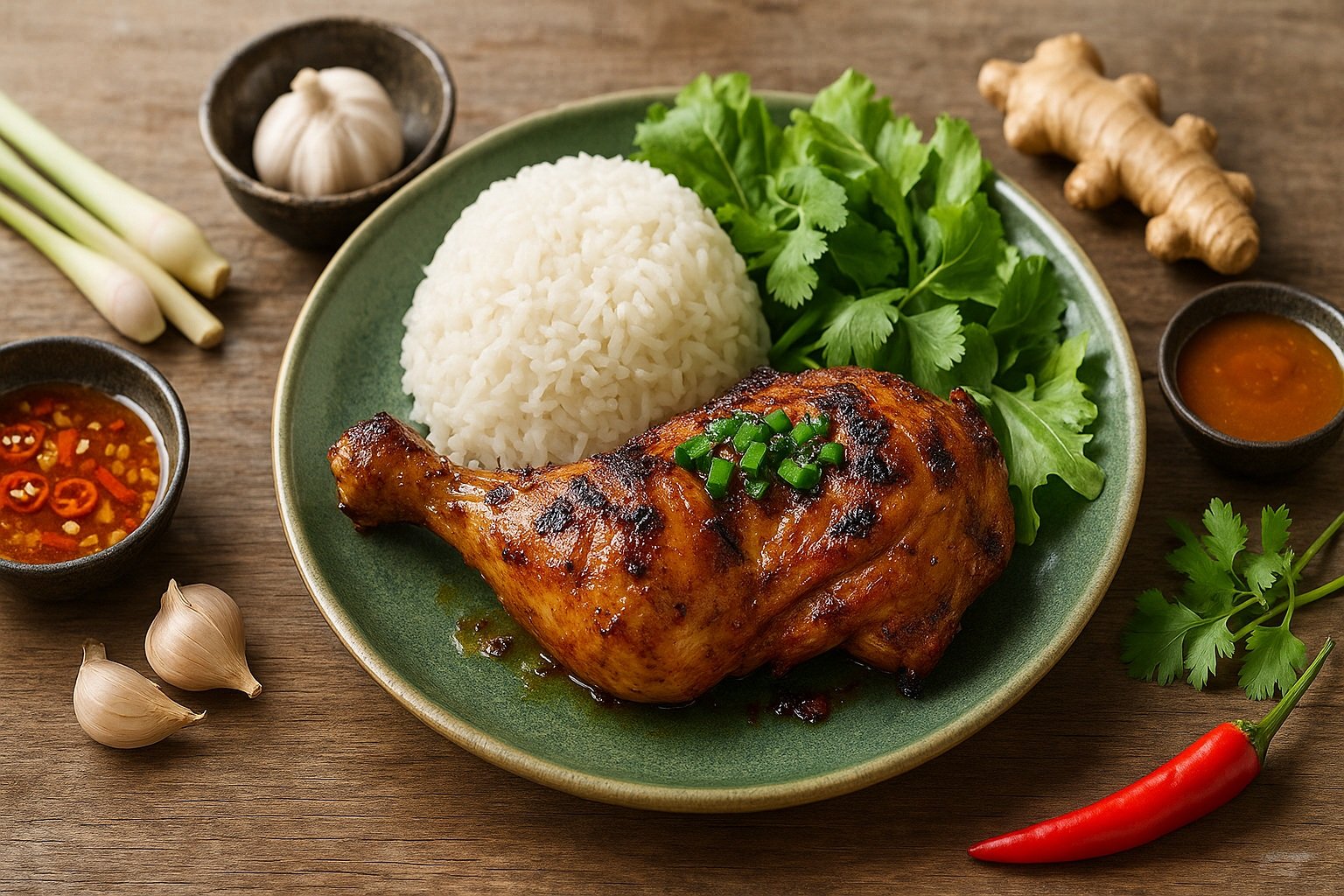
Gà Nướng (Grilled Chicken) is one of the most beloved meat dishes in Vietnamese cuisine. Chicken is marinated with garlic, fish sauce, lemongrass, soy sauce, honey, and various spices, then cooked over charcoal or on a grill. Thanks to this special marinade, the meat becomes both tender and rich in flavor. Its exterior turns golden and crispy, while the inside remains juicy and delicious. Usually served with rice or fresh vegetables, Gà Nướng is enjoyed both in daily meals and at special gatherings.
Prepared with different recipes in various regions of Vietnam, this dish is especially popular among street foods. It is often accompanied by sweet and sour sauces or chili sauce. As tasty as it is nutritious, Gà Nướng has become a favorite of both locals and tourists with its simple preparation and strong aroma. It offers an indispensable experience for those who want to explore the practical yet unforgettable flavors of Vietnamese cuisine.
16. Canh Chua – Sweet and sour fish soup, usually specific to the Mekong region.

Canh Chua is one of the most special soups of Mekong Delta cuisine and stands out with its sweet and sour balance. It is usually prepared with fresh ingredients such as fish, pineapple, tomatoes, okra, and bean sprouts. The sourness of the soup comes from tamarind, while its sweetness comes from pineapple. Aromatic ingredients such as fish sauce, garlic, and chili are added to these harmonious flavors, creating a soup that is both light and refreshing.
Canh Chua is especially indispensable on hot summer days. It is usually served with steamed rice or fried fish. Both nutritious and appetizing, this soup is not just a dish but also a flavor that reflects the cultural and geographical richness of the Mekong region. As one of the best examples showing the balanced flavor approach of Vietnamese cuisine, it attracts the attention of both locals and tourists.
17. Thịt Kho Tàu – Braised caramelized pork with eggs.
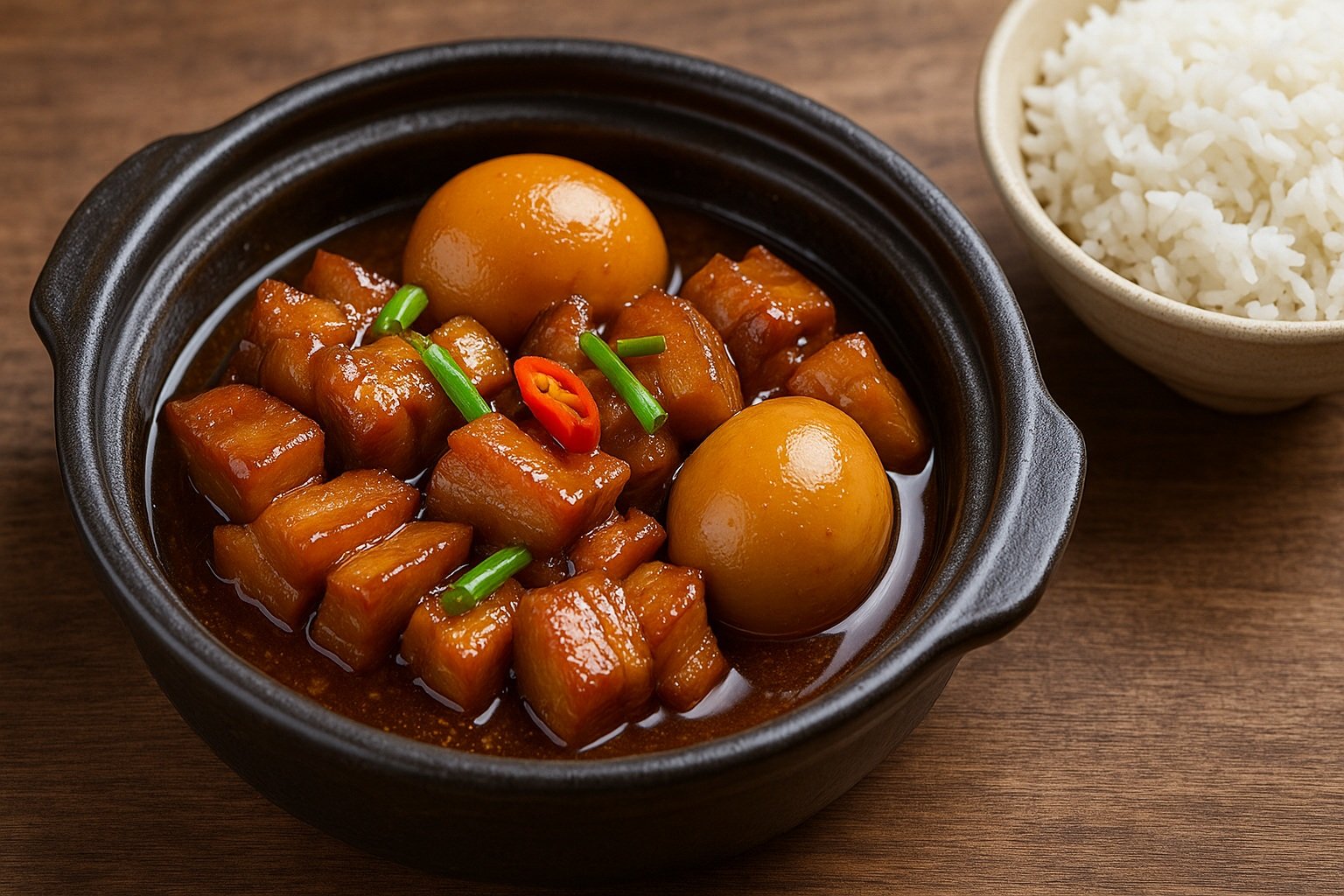
Thịt Kho Tàu is one of the most traditional dishes of Vietnamese cuisine and is often an indispensable part of family meals. Pieces of pork are caramelized with soy sauce, fish sauce, and sugar. Boiled eggs are added, enriching it both visually and in flavor. Thanks to the slow cooking method, the meat becomes tender, while the sauce offers a dark, aromatic, and slightly sweet taste.
This dish is usually served with steamed white rice and is enjoyed both in daily meals and on special occasions. In southern Vietnam, it is especially prepared during Tết (Lunar New Year) as one of the most important dishes on family tables. The balance of sweet, salty, and aromatic flavors makes Thịt Kho Tàu not just a dish but also a flavor symbolizing the warmth of Vietnamese culture and family bonds.
18. Bánh Bao – Steamed buns filled with meat or vegetables.
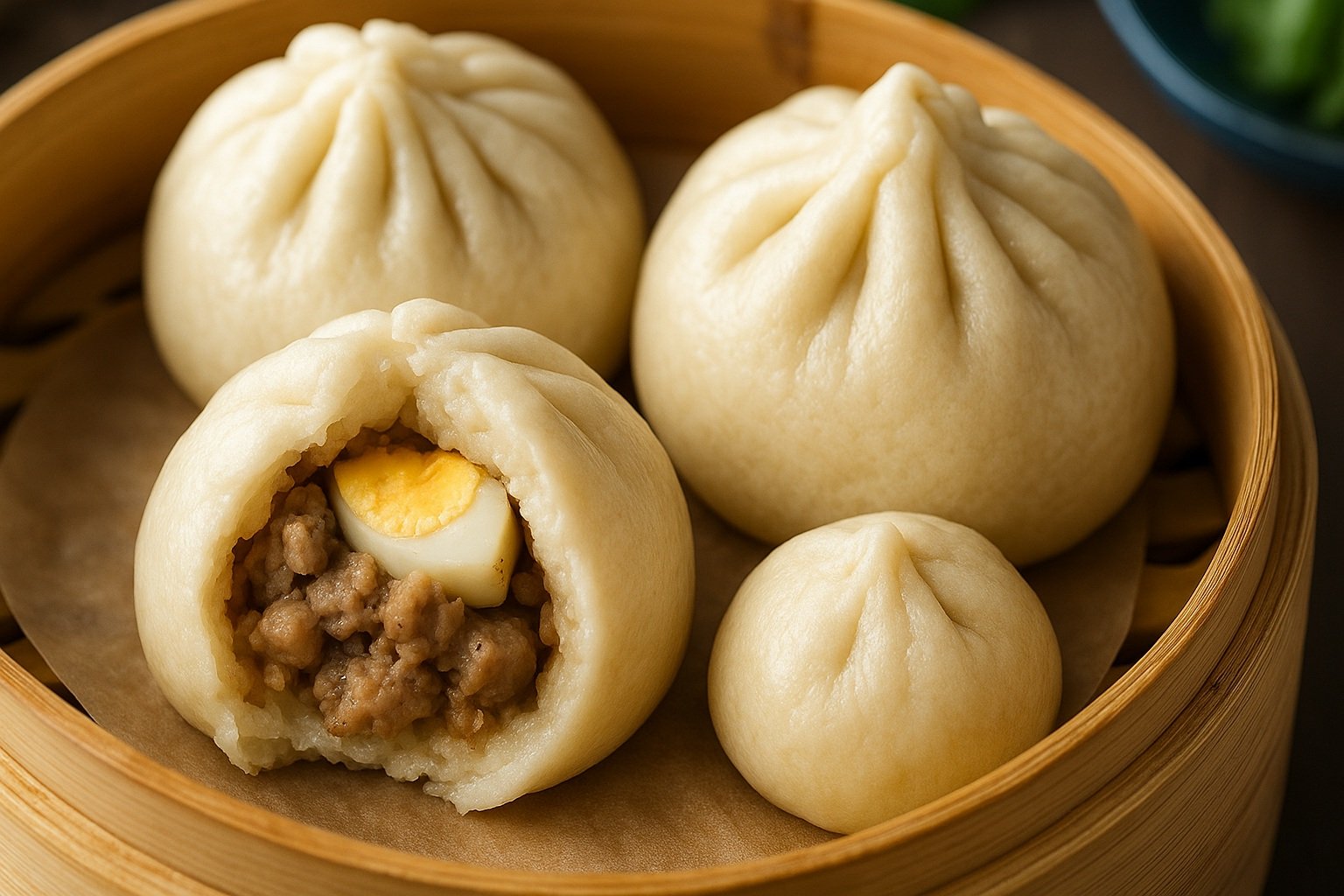
Bánh Bao is a practical and delicious food in Vietnamese cuisine, enjoyed both in daily life and on special occasions. Influenced by Chinese cuisine, these steamed buns stand out with their soft and slightly fluffy texture. The filling is usually prepared with minced meat, chicken, mushrooms, eggs, or vegetables. They come in both savory and sweet varieties and catch attention at street vendors’ stalls with their warm steam.
In Vietnam, Bánh Bao is especially consumed for breakfast or as a snack, popular for its filling and easily portable nature. It is also preferred as a quick meal during travels or after work. Loved by both children and adults, this delicacy is one of the finest examples that bring together the practical and traditional flavors of Vietnamese cuisine.
19. Bánh Pía – Pastry filled with sweet beans, salted egg yolk, and durian.
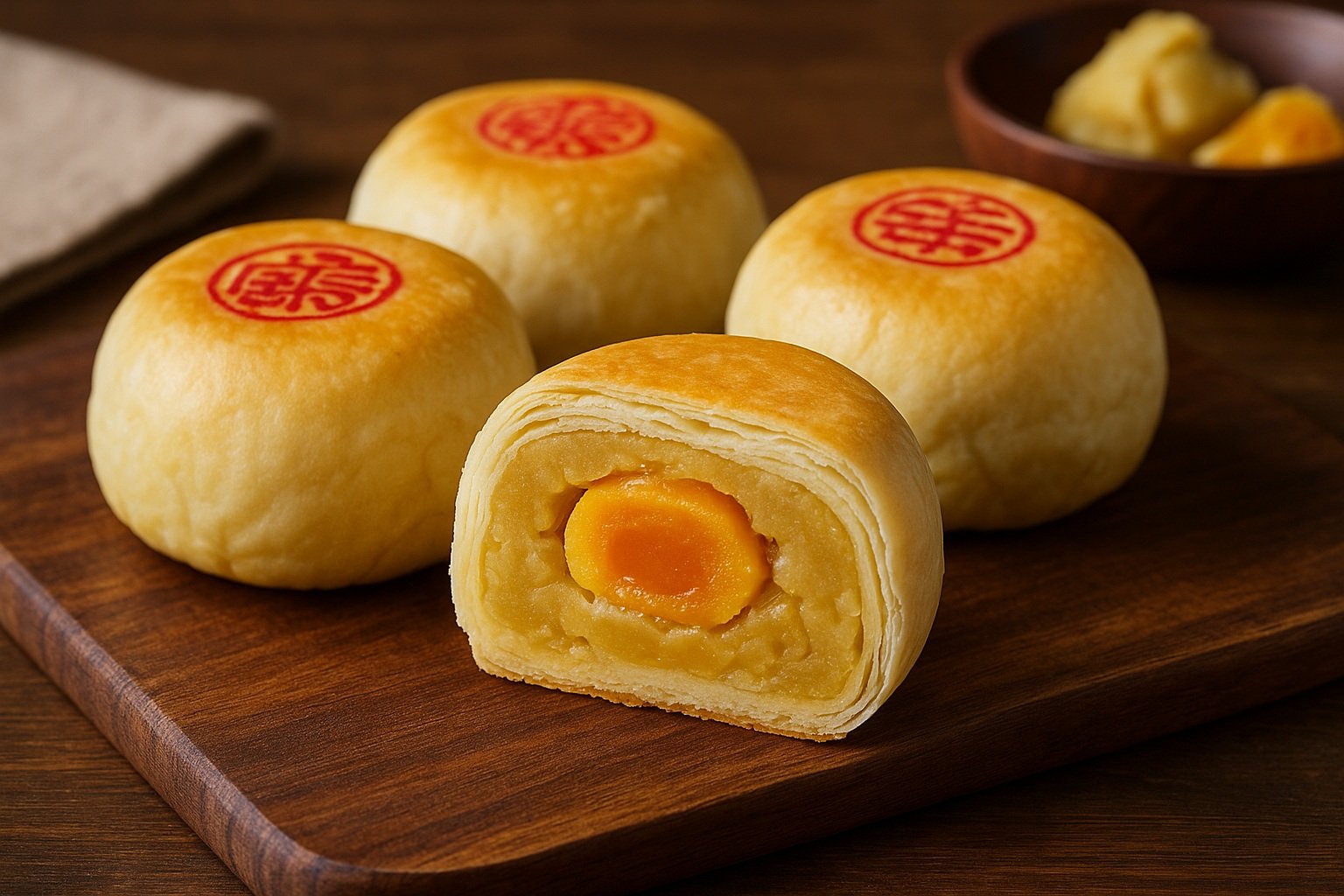
Bánh Pía is a traditional pastry popular especially in the southern regions of Vietnam. It is made with sweet bean paste, salted duck egg yolk, and durian fruit, known for its strong aroma. The outer layer is covered with thin, multi-layered pastry dough and baked in the oven. With this structure, it offers both a crispy and soft texture at the same time. The contrasting flavors of the fillings give Bánh Pía a very distinctive taste.
Usually served in small, round portions, this dessert is preferred on special occasions and as a gift. The balance of sweet and salty flavors combined with the strong aroma of durian creates a unique experience. For those traveling to southern Vietnam, Bánh Pía is one of the local specialties that must be tried, reflecting both the gastronomic diversity and dessert culture of the region.
20. Ca Kho Tộ – Caramelized fish dish cooked in a clay pot.
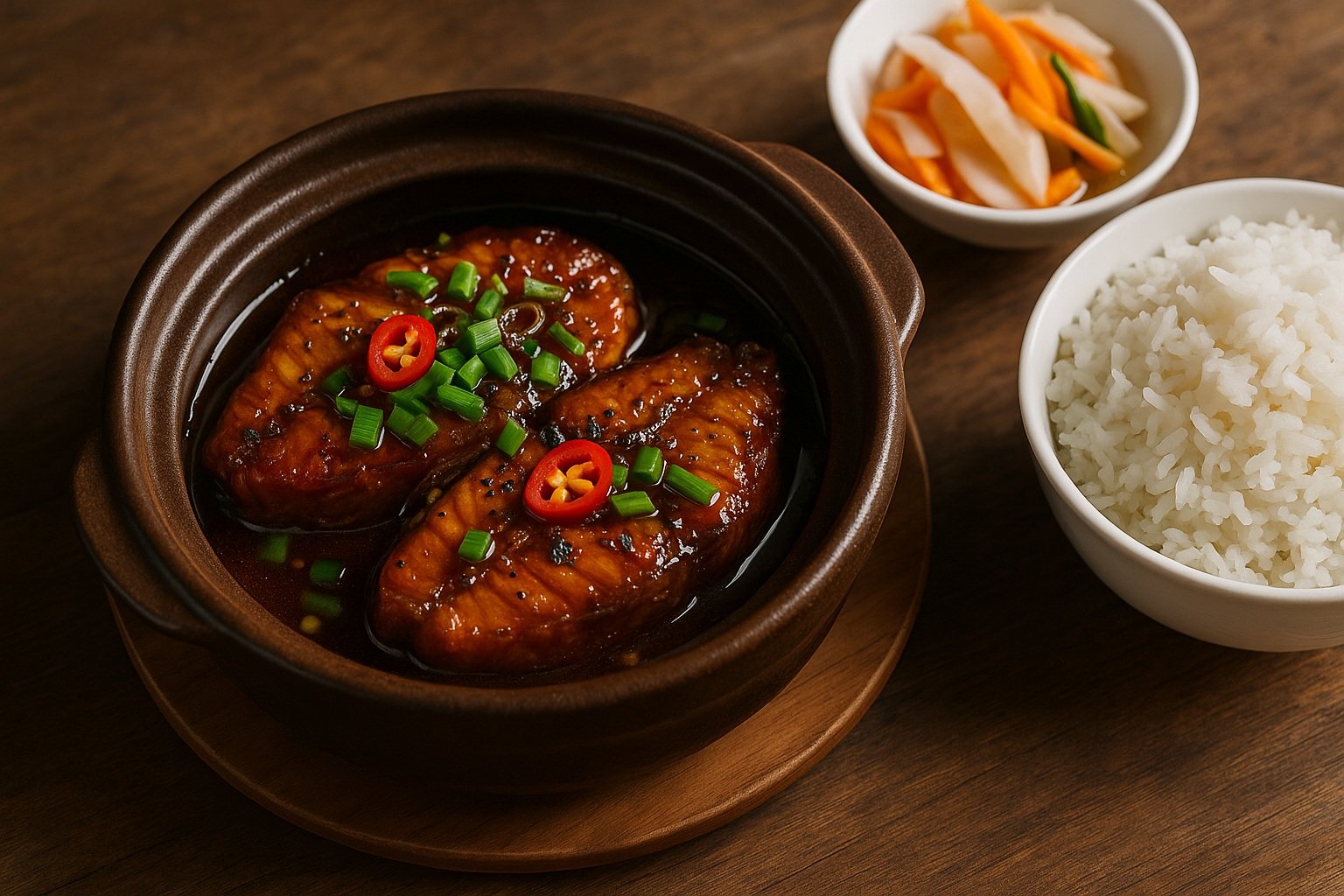
Cá Kho Tộ is one of the most traditional and beloved dishes of Vietnamese cuisine. Cooked in a clay pot, this dish is prepared by slowly braising fish in a caramelized sauce. The sauce is usually enriched with fish sauce, sugar, soy sauce, garlic, chili, and sometimes coconut water. During cooking, the fish absorbs this sauce, becoming both richly flavored and tender. The clay pot helps distribute heat evenly, further enhancing the taste of the dish.
Cá Kho Tộ is usually served with steamed white rice and is an indispensable part of family meals in daily life. The balance of sweet, salty, and mildly spicy flavors makes this dish one of the finest examples of Vietnamese cuisine. Both nutritious and filling, Cá Kho Tộ is especially widely consumed in southern Vietnam. This dish not only appeals to the palate but also reflects the traditional cooking methods and cultural richness of Vietnam.
